The Influence of Wide Women's Belts on Fashion Styles
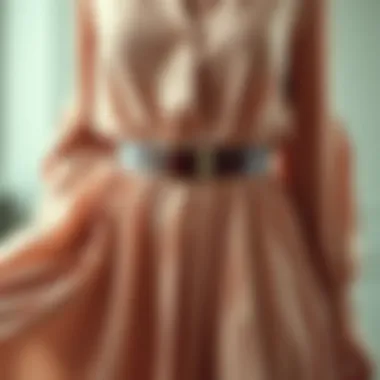
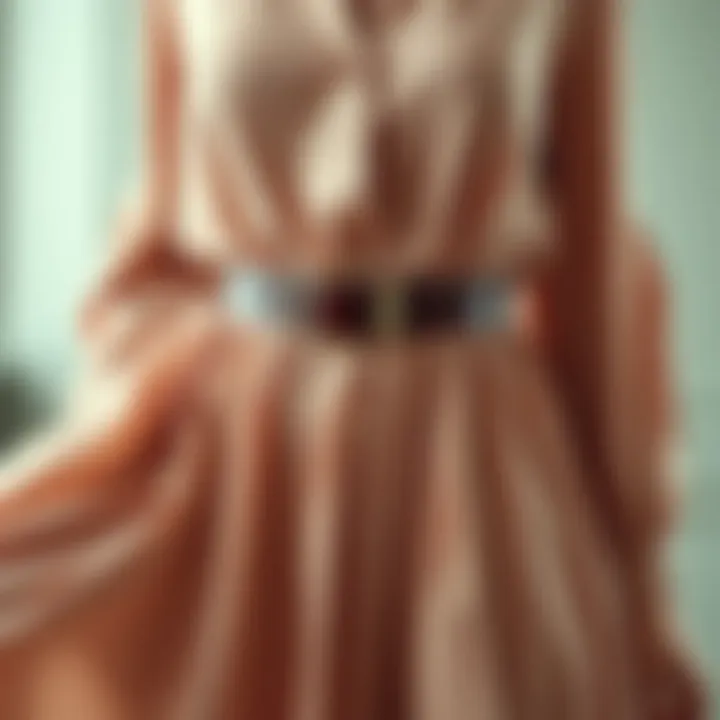
Intro
Wide women’s belts are more than just functional accessories; they hold the potential to alter the overall aesthetics of dresses and outfits significantly. These belts, which have a unique way of accentuating the waist and creating visual interest, have woven themselves into the fabric of modern fashion. From the catwalk to the everyday style, the significance of wide belts cannot be overstated. They enhance silhouette, add layers to an outfit, and can even transform a basic dress into a statement piece.
The historical relevance of wide belts is also worth noting. In past decades, they emerged as symbols of both status and style, often seen in the wardrobes of fashion trailblazers. Today, they are celebrated for their versatility, fitting seamlessly within various fashion trends—from boho chic to urban edge. Understanding how to use these belts effectively is crucial for fashion enthusiasts and boutique owners who seek to embody fluidity and creativity in styling.
In the sections below, we will dissect the latest fashion trends involving wide belts, delve into the materials that shape their presence, and examine how to integrate these accessories into a variety of styles and occasions.
Historical Overview of Women's Belts
Understanding the historical context of women's belts opens a window into how these accessories have shaped and been shaped by fashion trends throughout the years. Belts are not merely functional items; they are significant style statements that have transformed dress aesthetics. By examining the evolution of women's belts, we gain insight into their role in defining body shapes, establishing trends, and even reflecting cultural changes. This section emphasizes not only the aesthetic contribution of belts but also their multifaceted significance in women's fashion history.
Origin and Evolution of Belts in Women's Fashion
Belts date back to ancient times, with their origins rooted in practical necessity. Initially, they served as a means to secure garments, especially for working-class women engaged in physical labor. As societies evolved, so did the purpose of belts. In the medieval and Renaissance periods, women's belts began to morph into more decorative items, often heavily embellished. This shift signified the first steps towards belts being regarded as fashion statements rather than mere utility.
By the Victorian era, belts often became a symbol of femininity. Corsetry had its heyday, and belts played an integral role in accentuating the waistline, a key aspect of the hourglass figure that women aspired to achieve. Designers began experimenting with materials and styles, introducing wide belts adorned with intricate details—representing both empowerment and social standing.
In contemporary fashion, wide women's belts have found a place as essential accessories. They serve to cinch waists on dresses and enhance silhouettes, bridging the gaps between classic and modern aesthetics. This evolution showcases how wide belts have remained relevant, adapting seamlessly to changing wardrobes while maintaining their core function of enhancing femininity and style.
Cultural Significance Through the Ages
Throughout history, women’s belts have carried substantial cultural meaning beyond their aesthetic appeal. The belt's role in different cultures reveals variations in symbolism, status, and identity. For instance, in many Indigenous cultures, woven belts symbolize craftsmanship and community heritage. These handcrafted pieces are often embedded with symbols that tell stories or represent identities specific to the tribe or locality.
During the 20th century, the use of wide belts evolved alongside women's liberation movements. They became a statement of rebellion against the constricting norms of fashion that dictated what women could wear. As women fought for rights and freedom, belts morphed into symbols of empowerment, with wide designs reflecting confidence and self-expression.
Fashion designers often draw upon this rich history, contributing to how belts continue to make cultural statements today. Many brands focus on sustainability and ethically sourced materials, echoing the cultural significance of belts in traditionally rich designs that respect craftsmanship and heritage.
Understanding Wide Women's Belts
Wide women's belts serve as more than just accessories; they are pivotal elements in fashion that can significantly alter the way dresses are perceived and worn. By understanding these belts, fashion enthusiasts and boutique owners can better appreciate the nuances of styling, which can ultimately enhance wardrobe choices. In this section, we will highlight how wide belts influence not only aesthetics but also practicality in achieving unique looks.
Wide belts often evoke an image of boldness and sophistication. They emphasize the waist, which is a focal point in many outfits, thus creating an alluring silhouette. Understanding the nuances of these belts also encompasses their diverse range of materials, colors, and patterns, which can complement various dress styles. The versatility they offer means wide belts can transition seamlessly from casual daywear to formal gatherings, adapting to the wearer’s needs. This inherent adaptability underscores their importance in the contemporary fashion landscape.
Definition and Characteristics of Wide Belts
Wide belts can be defined by their breadth, which typically exceeds three inches, distinguishing them from their narrower counterparts. They come in various styles, from simple, sleek designs to more elaborate, embellished options. Here are some key characteristics of wide belts that make them stand out:
- Shape and Structure: The size of the belt provides a structured look, allowing it to hold garments in place while also altering how the body shape is perceived.
- Versatility in Styling: Wide belts can be styled in multiple ways—worn over dresses, tops, or even layered on outerwear, making them a versatile addition to any outfit.
- Material Variations: They are made from a range of materials, including leather, fabric, and elastic, each contributing its unique aesthetic and feel.
- Color and Pattern Choices: Available in an array of colors and patterns, wide belts can elevate a simple outfit or blend into a more complex ensemble, depending on their design.
Understanding these features provides insight into why wide belts are embraced in modern fashion.
Differences Between Wide Belts and Traditional Belts
The distinction between wide belts and traditional narrower belts is important for anyone looking to refine their wardrobe. While both serve similar basic purposes—cinching garments and enhancing waistlines—there are several striking differences that emerge:
- Width and Coverage: As previously mentioned, the most apparent difference is the width. Traditional belts often measure one to two inches, whereas wide belts are three inches or more. This difference significantly impacts how they fit and function.
- Aesthetic Appeal: Wide belts tend to make bolder fashion statements due to their substantial size. They can serve as a primary focal point in an outfit, offering visual interest that traditional belts typically do not.
- Functional Use: Many wide belts are designed with added functionality in mind, such as pockets for small items or unique buckles that add flair. This ability to combine style with utility can be appealing for practical wearers.
- Occasions for Use: Generally, wide belts are more associated with high-fashion looks or avant-garde styles. Traditional belts often serve more utilitarian purposes and are frequently used in casual or formal settings without making a bold statement.
Understanding these differences is crucial for anyone wishing to enhance their fashion repertoire. As wide belts continue to gain prominence, their role in dress aesthetics becomes ever more relevant.
The Aesthetic Contribution of Wide Belts
The incorporation of wide women's belts into fashion is not just a fleeting trend; it’s an exploration of how accessories can redefine styles and silhouettes. They hold a unique place in wardrobes, acting as transformative agents that elevate a simple outfit into a statement. Far beyond mere functionality, wide belts enhance visual appeal by drawing attention to the waist, thus emphasizing body shapes and creating balance in proportions. This section dives into how specific body shapes interact with wide belts, outlining their aesthetic contributions.
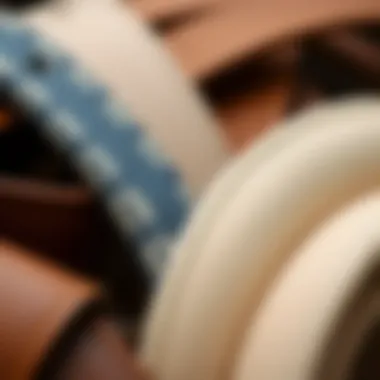
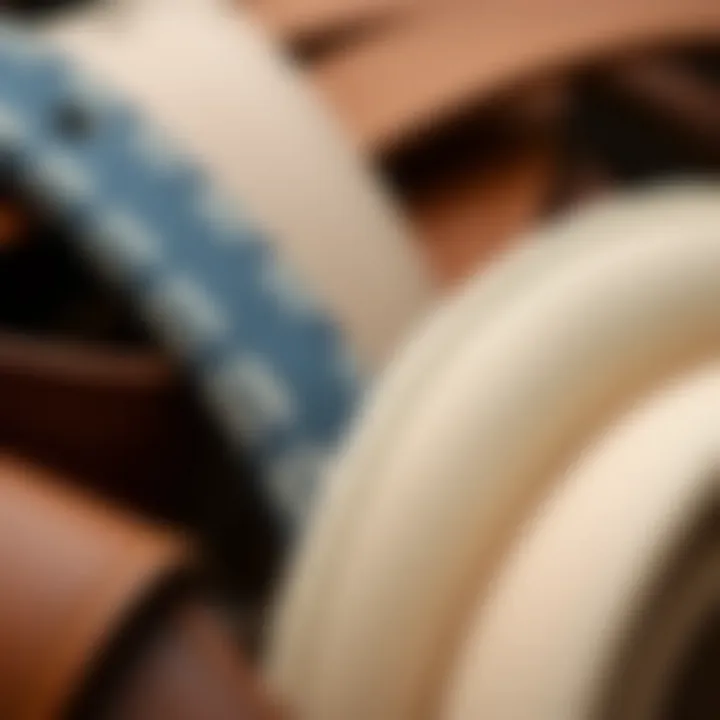
Enhancing Silhouettes and Body Shapes
Pear Shape
For many fashion enthusiasts, the pear shape, characterized by a smaller waist and fuller hips, is where wide belts shine the most. The ability of a wide belt to cinch at the waist effectively highlights this natural curve, offering a flattering silhouette. This aesthetic is often beneficial, making the waist appear even slimmer relative to the hips. By doing so, wide belts can effortlessly morph a basic dress into a more tailored masterpiece, bringing out the best features of the pear shape. One unique factor to consider is the contrast of the belt color with the dress; a bold belt can make for an even more striking appearance, leading to an eye-catching ensemble.
Hourglass
The hourglass figure is iconic in the realm of fashion, celebrated for having balanced proportions of bust and hips, with a defined waist. Wide belts serve this body shape well by accentuating its curves further. They not only enhance the waist but can also alter the appearance of the bust and hips, creating an overall harmonious look. This ability to shape the figure can make hourglass silhouettes particularly appealing for various occasions, from a casual outing to formal events. A downside might be that if selected poorly—like using a belt too wide or in unflattering colors—it can overwhelm the form, rather than enhancing it. However, the right belt can act as a charm, drawing attention to the body's natural definition.
Rectangle
Women with a rectangle body shape often seek texture and dimension through their attire, as their silhouettes tend to lack defined curves. This is where wide belts come into play again, as they can create an illusion of a more pronounced waistline. By cinching the waist, a wide belt can add a visual break that enhances the upper and lower body proportions. This approach to styling can transform a rather linear silhouette into something more vibrant and appealing. Nonetheless, it’s crucial to choose a wide belt that complements the dress fabric and style; an overly rigid belt can clash with softer materials or fails to add the desired dimension.
Creating Visual Interest and Focal Points
A wide belt can act as a focal point for any outfit, drawing the eye and adding layers of complexity to a look. Not only does it break the monotony of a flat silhouette, but it also allows for creativity in styling. Vivid colors, patterns, or embellishments on wide belts can introduce a whole new level of flair, making an outfit feel fresh. By focusing on these elements, one can turn a traditional dress into a canvas for personal expression.
Styling Techniques for Incorporating Wide Belts
When it comes to styling fashion, wide women's belts can play a pivotal role. They are not just practical tools for holding up garments but also serve as creative elements in an outfit. This section sheds light on how to incorporate wide belts effectively in various dress styles, highlighting essential techniques that elevate aesthetic appeal.
Pairing with Various Dress Styles
Dressing choices are a canvas, and wide belts can be the brush strokes that provide depth and definition. Let us examine how they harmonize with three popular dress styles: maxi dresses, sheath dresses, and A-line dresses.
Maxi Dresses
Maxi dresses are celebrated for their flowing silhouettes and comfort. The key characteristic of a maxi dress lies in its length, which typically reaches down to the ankles or floor. This extended design can sometimes lead to a shapeless look, but this is where wide belts truly shine. They create a more defined waist, adding structure to an otherwise loose ensemble. When cinched at the waist, a wide belt can help reveal the body's natural curves while enhancing the overall silhouette of the maxi dress.
Advantages:
- They transform a simple flowy maxi into a more tailored look.
- Wide belts can introduce contrasting textures or colors, drawing attention to the waist.
Disadvantage:
- It might overwhelm petite frames if the belt width is too large.
Sheath Dresses
Sheath dresses are known for their fitted design, often hugging the body from the shoulders down to the hem. This particular style emphasizes the figure and can exude sophistication. Wide belts paired with sheath dresses can heighten this effect, emphasizing the waist and creating an hourglass shape. The versatility of satin or leather belts complements the elegance of sheath dresses, allowing for a range of looks that can transition seamlessly from offices to evening outings.
Advantages:
- They enhance body shape and add a stylish focal point to professional attire.
- Wide belts can come in various materials, making it easy to switch up styles depending on occasion.
Disadvantage:
- A poorly chosen belt can disrupt the sleek flow of a sheath dress.
A-Line Dresses
A-line dresses are a staple for those seeking balance and ease. The signature flared design from the waist down offers a flattering fit for many body types. When accessorizing with a wide belt, the goal is to draw attention to the waistline, enhancing the dress's natural flow. These belts can bring out patterns or colors in the dress, turning a basic outfit into something memorable.
Advantages:


- They can create a visual line that elongates the legs and visually slim the waist.
- A-line dresses styled with wide belts can easily transition from day to night.
Disadvantage:
- If the belt style clashes with the dress design, it might detract from the outfit.
Layering and Textural Considerations
Layering is an art in itself. Wide belts can assist in creating well-organized layers that look intentional rather than haphazard. For example, wearing a belted cardigan over a fitted dress can be an elegant way to include texture without overwhelming the outfit. Likewise, incorporating materials like knitted fabrics or soft denim can add a cozy feel to an ensemble.
When considering textures, it's essential to balance them carefully. A leather belt atop a fabric dress can create an appealing contrast, while a fabric belt may work wonderfully with a more structured garment. This careful thought about textures leads to richer outfit compositions, reinforcing the importance of wide belts in women's fashion.
"Fashion is about what you wear; style is about how you wear it."
Fabric Choices for Wide Women's Belts
When it comes to wide women's belts, the choice of fabric plays a crucial role not just in their construction, but also in their aesthetic contribution to an outfit. The material influences not only the belt's durability but also its versatility, ease of care, and the way it interacts with different styles of dresses. Women today are more conscious of fabric choices due to the link between materials and overall aesthetics, climate impact, and personal style preferences.
Popular Materials in Belt Construction
Leather
Leather is often considered the gold standard when it comes to wide belts. Its robustness is matched only by its luxurious appeal, making it a quintessential choice in many fashion circles. The key characteristic of leather is its durability, which means that a well-made leather belt can outlast its fabric or elastic counterparts significantly. What's more, leather develops a beautiful patina over time, adding character and depth to the accessory.
However, while its benefits are compelling, it has its unique features too — for instance, the maintenance can be tedious, requiring regular conditioning to avoid cracking. Additionally, leather belts may not have the same stretchability found in other materials, which could limit comfort for some body types.
Fabric
Fabric belts, often made from cotton, denim, or synthetic blends, bring a different vibe to the table. The key characteristic of fabric is its lightness and flexibility. This allows for a myriad of designs, colors, and patterns, providing opportunities to express individual style. They can easily be washed and dried without too much fuss, making them a great, practical option for everyday wear.
On the downside, they may lack the durability and formality of leather belts. Fabrics can wear down quicker under stress or loosen over time, diminishing the structure. That said, their affordability means they can be easily replaced, which adds to their appeal.
Elastic
Elastic belts have gained popularity for their exceptional flexibility and comfort. A standout feature of elastic is its ability to adapt to a variety of body shapes, providing a snug fit without constricting movements. This makes elastic belts an excellent option for individuals who prioritize comfort alongside style.
The key characteristic of elastic, however, is the tendency to stretch out over time. Although many contemporary designs incorporate elastic within a fabric or leather blend, pure elastic belts can sometimes lack the aesthetic appeal of their more structured counterparts. This dual nature of elastic — comfort versus longevity — is critical to consider, especially in the context of broader styling goals.
Sustainable Options in Belt Production
As consumers become more environmentally conscious, the demand for sustainable fabric choices has grown. Many brands are now exploring options like organic cotton, recycled materials, and plant-based leathers. These choices do not compromise on style while promoting eco-friendliness, contributing positively to the fashion industry.
Incorporating such materials into wide women's belts not only diverts from traditional leather and synthetic options but also resonates with a responsible consumer base. More than just aesthetics, choosing sustainable fabrics can reflect an individual's values and commitment to the environment.
Considerations regarding fabric choices can substantially affect a woman's wardrobe. A thoughtful selection offers not only personal style points but also supports sustainable practices. As the conversation around fashion continues to evolve, so too does the variety of fabrics available to create stunning, impactful wide belts.
Occasions for Wearing Wide Women's Belts
Understanding the occasions for wearing wide women's belts is crucial for fully appreciating their versatility and aesthetic contribution to fashion. Wide belts can be transformative elements in outfits, acting as connectors between different styles, colors, and textures. When incorporated thoughtfully, they can enhance a look by providing structure, emphasizing proportions, and offering a distinctive edge to personal style.
Casual Daywear
Casual daywear presents an opportunity for wide belts to show their fun and relaxed side without compromising on style. For instance, a wide fabric belt can easily add flair to a flowing sundress during a summer picnic. Complete the look with a pair of easy-going sandals, and you've got a balanced outfit that speaks comfort while making a subtle fashion statement.
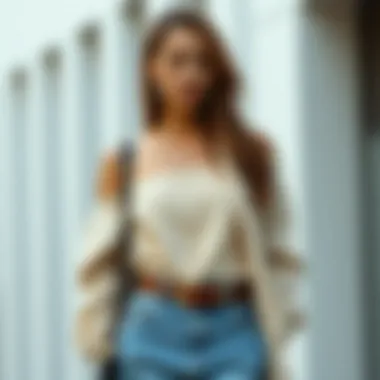

Additionally, pairing wide belts with high-waisted jeans and a tucked-in blouse creates an effortless chic vibe. This styling technique not only highlights the waist but also elongates the legs, creating a streamlined appearance that is ideal for brunch with friends or a leisurely stroll at the park. When opting for casual wear, it's worth considering the choice of colors and patterns; a vibrant or patterned belt can inject a pop of personality into a simple outfit, adding just the right amount of whimsy and playfulness.
"Accessories can differentiate your style and allow you to express your mood, and wide belts are the perfect tool for that."
Formal Events and Gatherings
Wide belts are not just reserved for casual occasions; they can elevate formal attire as well. Picture this: a classic black evening gown transformed by the strategic placement of a wide leather belt. This not only creates a beautiful hourglass silhouette but also acts as a visual focal point, drawing attention to the waist. Ensure the belt complements the dress—perhaps a satin finish for an added touch of elegance.
For formal gatherings, you can explore options that incorporate interesting materials, such as a velvet belt with embellishments, which can add depth and texture to an outfit. Such choices resonate well when attending galas, weddings, or sophisticated dinners, where every detail matters.
Wide belts also serve as great conversation starters; they have the potential to steal the show if styled correctly. When attending a cocktail party, a tailored jumpsuit with a statement wide belt can radiate confidence and individuality, setting you apart in a sea of typical attire.
Maintenance and Care of Wide Belts
Maintaining and caring for wide women's belts is not just about extending their life; it's about preserving the statement and aesthetic they bring to any outfit. Just like any other accessory, proper care can keep these belts looking fresh and vibrant, ensuring they continue to enhance your wardrobe. This section dives into essential cleaning practices, ideal storage solutions, and ways to assess the condition of your belts.
Cleaning and Storing Tips for Longevity
When it comes to cleaning wide belts, taking a bit of extra time can make all the difference. Here are some tips that can help:
- Regular Dusting: Use a soft, dry cloth to remove dust and dirt after each use. This simple step can prevent grime from settling into the material.
- Spot Cleaning: For any stubborn stains, it's best to perform spot cleaning rather than immersing the whole belt in water. Depending on the material, a small dab of mild soap mixed with water can work wonders.
- Material-Specific Care:
- Leather: Gently wipe with a damp cloth followed by a dry one. Applying a conditioner every few months can prevent cracking and maintain its luster.
- Fabric: For fabric belts, check the care label; many can be hand-washed or spot cleaned, but some may require dry cleaning.
- Elastic: These belts should be wiped with a damp cloth, avoiding harsh chemicals that could degrade the elasticity.
Storing your belts correctly is equally crucial. Here’s what you can do:
- Hang Them Up: Using a belt hanger or hook keeps the belts straight, avoiding creases that could damage their appearance.
- Avoid Sunlight: Prolonged exposure to sunlight can cause fading. Storing in a dark, dry place will keep colors vibrant.
- Roll, Don’t Fold: For cloth or flexible belts, consider rolling them up to prevent lines.
Assessing Wear and Damage
Regularly assessing the condition of your belts is an important part of maintenance. Doing this prevents unsightly damage and can save the belt from further deterioration:
- Check for Cracks or Fraying: Inspect leather for cracks and fabric for signs of fraying. Spotting such issues early can allow for timely repairs.
- Buckle Integrity: Ensure that the belt buckle is still securely fastened and functioning. A loose or broken buckle can compromise the belt's usability.
- Elasticity Examination: For stretchy belts, check if they still maintain their shape. If they have become loose or saggy, it might be time to replace them.
Pro Tip: Keeping a log of your belts' care routines and assessments can provide you with insights into which styles wear out faster and need more attention.
By leveraging these maintenance tips, wide women's belts can continue to be not just functional accessories but also signature pieces in your closet. Taking the extra steps to care for your belts can ensure they remain a staple in your wardrobe for years to come.
Future Trends in Women's Belts
The realm of fashion is ever-evolving, and the trends surrounding women's belts are no exception. With an increasing emphasis on personal expression and individuality in styling, the role of wide belts has shifted from mere accessory to a valid statement piece. Understanding future trends in women's belts is essential for enthusiasts and boutique owners alike, as it influences design choices and consumer preferences.
The importance of this topic stretches beyond the aesthetics of fashion. As we explore innovative designs and functional features, the implications can reshape how belts are perceived in wardrobes. Wider belts are adaptable and multifunctional, serving both a stylistic and functional purpose.
Innovative Designs and Functional Features
Innovation in design is a primary driver of fashion sustainability. The future is leaning towards creative materials, textures, and closure mechanisms. Wide women's belts are making bold moves, characterized by not only their width but also dynamic designs that play with patterns and colors.
- Multifunctionality: Innovations such as detachable elements allow wide belts to transform from a simple accessory into a focal point. A belt that can also function as a bag or come with interchangeable buckles can cater to a variety of occasions and outfits.
- Customizable Features: Today’s consumers love customization. Brands are introducing belts with adjustable lengths or snap-on features that allow for personal flair while maintaining comfort.
- Artistic Approaches: Both avant-garde and minimalist designs are gaining traction. Unconventional materials such as cork or recycled fibers are becoming popular, defining a new aesthetic while pushing for sustainability in fashion.
"In fashion, the only constant is change. Wide belts are not just an accessory; they translate personal identity and creativity into wearable art."
This innovative approach to design not only caters to the fashion-forward individual but also reinforces a sense of environmental awareness. By incorporating sustainable materials, designers can appeal to a conscious market that values quality and ecological impact.
Influence of Technology on Accessories
Technology is interweaving itself into all aspects of life, and accessories like women’s belts are no exception. Wearable technology is finding its way into fashion items, sparking a fascination among audiences eager for functionality along with aesthetics.
- Smart Belts: Consider belts equipped with built-in health trackers or smart sensing technology. These can monitor body metrics or provide notifications right at the wearer’s waist. The marriage of tech and fashion can transform a fashion accessory into a practical tool.
- Virtual Try-Ons: The rise of AR (Augmented Reality) is shaping how consumers engage with fashion. Virtual try-on options allow customers to see how a belt complements various outfits without the hassle of physically trying them on. This could change the purchasing habits, saving time and resources.
- E-Commerce Enhancements: Online boutiques are beginning to utilize tech to enhance customer experience, integrating AI for personalized suggestions based on past purchases and preferences, thus making it easier for customers to select the right wide belt to complete their look.
As the fashion industry continues to adapt and innovate, future trends in women’s belts appear promising. These accessories can transcend traditional boundaries, evolving into essential aspects of personal style, wellness, and technology. Boutique owners who acknowledge these shifts can better align their inventories with market demands, ensuring they remain relevant in a fast-paced, ever-changing landscape.







